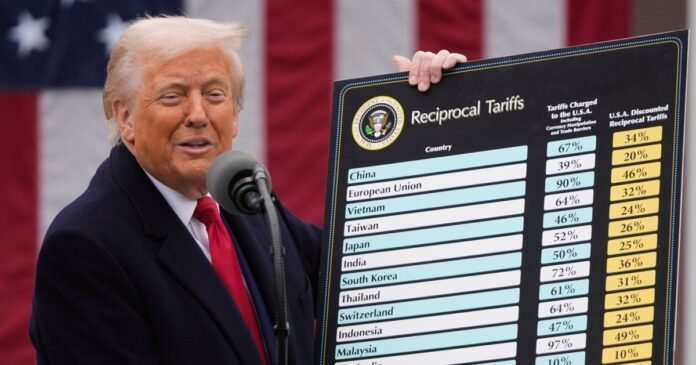US trade partners are racing to negotiate deals to avoid being slapped with steep tariffs from this week.
The global economy is on tenterhooks in the run-up to United States President Donald Trump’s July 9 deadline for dozens of countries to reach trade deals or face sharply higher tariffs.
Wednesday’s deadline comes after Trump announced in April a 90-day pause on his steepest tariffs after his “Liberation Day” plans sent markets into a tailspin.
With billions of dollars in global trade at stake, US trade partners are racing to negotiate deals to avoid damage to their economies amid continuing uncertainty over Trump’s next moves.
The Trump administration has indicated that trade partners that fail to reach deals with the US will face higher tariffs, but there are big question marks around which countries will be hit and how hard.
On Sunday, Trump said he would begin sending letters to particular countries this week outlining new tariff rates, while also indicating that he had sealed a number of new trade deals.
Trump told reporters that he would send a letter or conclude a deal for “most countries”, without specifying any by name, by Wednesday.
In an interview with CNN on Sunday, US Treasury Secretary Scott Bessent said countries that do not reach a deal would face higher tariffs from August 1.
Bessent disputed the suggestion that the deadline had moved and said tariffs for affected countries would “boomerang back” to the levels originally announced on April 2.
“There will be no exceptions to this policy. Thank you for your attention to this matter!” Trump said in a post on his Truth Social platform.
“It’s getting harder to guess what might happen given conflicting information from the White House,” Deborah Elms, the head of trade policy at the Hinrich Foundation in Singapore, told media.
“With the lack of ‘deals’ to announce before July 9, I’m not surprised that the US is both issuing threats of new, potentially higher rates to be imposed in letters and suggesting that deadlines could be extended to some if offers are deemed to be sufficiently attractive.”
So far, only China, the United Kingdom and Vietnam have announced trade deals, which have reduced Trump’s tariffs but not eliminated them.
Under the US-China deal, tariffs on Chinese goods were reduced from 145 percent to 30 percent, while duties on US exports fell from 125 percent to 10 percent.
What will happen when the deadline expires?
The deal, however, only paused the higher tariff rates for 90 days, rather than scrapping them outright, and left numerous outstanding issues between the sides unresolved.
The UK’s agreement saw it maintain a 10 percent tariff rate, while Vietnam saw its 46 percent levy replaced by a 20 percent rate on Vietnamese exports and a 40 percent tariff for “transshipping”.
On Sunday, The Washington Post reported that the EU, the US’s largest trading partner, was working to conclude a “skeletal” deal that would defer a resolution on their most contentious differences before the deadline to avoid Trump’s mooted 50 percent tariff.
India’s CNBC-TV18 also reported on Sunday that New Delhi expected to finalise a “mini trade deal” within the next 24-48 hours.
The CNBC-TV18 report, citing unnamed sources, said the agreement would see the average tariff rate set at about 10 percent.
Andrew K McAllister, a member of Holland & Knight’s International Trade Group in Washington, DC, said while Trump is likely to announce a small number of deals that resemble those signed with China, Vietnam and the UK, most countries are probably looking at significant across-the-board tariffs.
“My view is that tariffs are here to stay,” McAllister told media.
“I view the bargaining chip to be the level at which the tariff is set. For countries in which the president and administration view tariffs and other non-tariff barriers against US products as significant, he is much more likely to impose higher levels of tariffs.”
Economists widely agree that steep tariffs over a sustained period would push up prices and hinder the growth of both the US and global economies.
The World Bank and the Organisation for Economic Co-operation and Development (OECD) last month downgraded their outlook for the global economy, cutting their forecasts from 2.8 percent to 2.3 percent, and from 3.3 percent to 2.9 percent, respectively.
At the same time, anticipating the impact of Trump’s trade war has been made more challenging by his administration’s repeated U-turns and conflicting signals on tariffs.
Trump’s steepest tariffs have been put on pause, though a 10 percent baseline duty has been applied to all US imports and levies on Chinese exports remain at double-digit levels.
JP Morgan Research has estimated that a 10 percent universal tariff and a 110 percent tariff on China would reduce global gross domestic product (GDP) by 1 percent, with the hit to GDP falling to 0.7 percent in the case of a 60 percent duty on Chinese goods.

